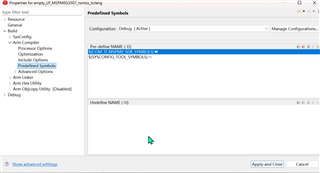Tool/software:
Hi Compiler experts,
I have below question on TI ARM CLANG Complier.
Refer below examples:
A.h files:
#define TEST 1
B.h files:
#ifndef TEST
#define TEST 2
#endif
There has two files give the same macro definition, I want to know how the compiler process these macro definition:
I am concerning whether there has the risk that sometimes it will process the B.h files at first, then it will define twice and make the error occur.
Meanwhile, the second question is that, what the marco definition difference between the pre-definition in project property and manually define it in main.c files?

Looking forward to your feedback.
B.R.
Sal

